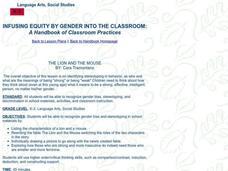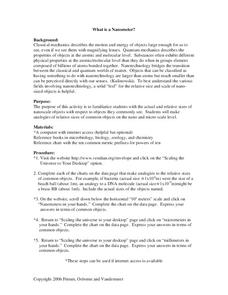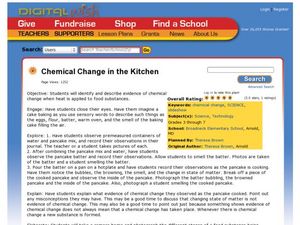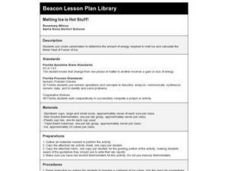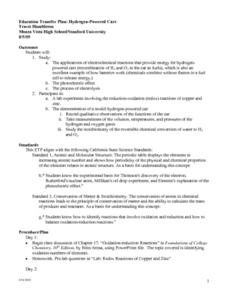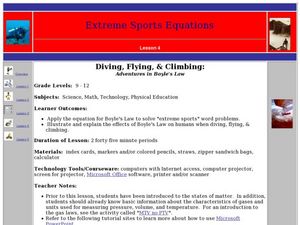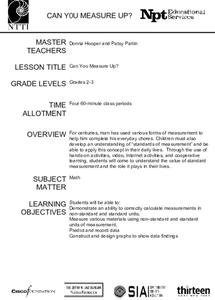Curated OER
THE LION AND THE MOUSE
Students listen to a story about different types of animals and explore how they all need each other, just like people do.
Curated OER
It's All About Me
Students engage in a variety of activities to develop the skills they need to answer questions about themselves. They respond to questions relating to their ages, names and favorite colors.
Curated OER
Que te gusta comer? What Do You Like to Eat?
Eighth graders examine their preferences concerning foods, beverages and eating habits during different meals. A variety of exercises in listening, speaking, reading and writing will be provided to ensure that students discuss their...
Curated OER
Nanofibers on Your Clothes
Students relate the presence of nanofibers in clothing to its ability to repel stains. They observe and contrast the characteristics of nanofiber, Scotchguard treated, and regular fabric then test the stain resistance of each fabric...
Curated OER
What is a Nanometer?
Students develop a concept of the relative size of objects in the nanoscale. They complete an internet assignment using the website,"Scaling the Universe to Your Desktop". Using analogies to common objects they get an appreciation for...
Curated OER
Science: Floating and Sinking Objects
Second graders discuss why some objects float while others sink. They examine various objects and predict whether or not they will sink or float. Students discover the properties needed for objects to float.
Curated OER
Conservation of Mass
In this conservation of mass worksheet, students design an investigation to demonstrate the Law of Conservation of Mass. Students describe their investigation, collect data, graph the data and write a conclusion about what they discovered.
Curated OER
Diaper Inquiry
Fifth graders carefully examine and investigate the products contained in a diaper. They particularly analyze the crystal sodium polyacrylate, a product developed for use in astronaut diapers. They follow the scientific method, forming...
Curated OER
Somethin' Sweet
Students make their own candy. In this science lesson plan, students observe how molecules interact with each other in physical changes and observe how the addition of heat can cause molecules to interact and form new molecules in...
Curated OER
Chemical Change in the Kitchen
Students examine chemical changes to food. In this chemical changes lesson, students make foods and observe the changes. The changes are recorded in an observation journal. Students photograph food they make at different stages in the...
Curated OER
Melting Ice is Hot Stuff!
Fourth graders determine the amount of energy required to melt ice using a calorimeter. They calculate the Molar Heat of Fusion of Ice.
Curated OER
Hydrogen Powered Cars
Learners apply the principles of chemistry to investigate the concept of how a hydrogen powered car works. They study the electrochemical reactions that provide the energy source. Students also record observations in the functioning of a...
Curated OER
Hot Cans and Cold Cans
Students investigate the physics of heating and cooling through conduction, convection, and radiation. Working in groups, they determine the best way to cool a can of water and warm a can of water. Temperature is taken at five minute...
Curated OER
Chemical Changes
Fourth graders examine and identify chemical and physical changes in a variety of substances. They observe a vinegar and baking soda demonstration, and a water, laundry detergent, and Epsom salt mixture demonstration. They discuss the...
Curated OER
Diving, Flying, & Climbing
Learners explore Boyle's Law. In this Boyle's Law instructional activity, students complete problems involving Boyle's Law. They examine the effects of Boyle's Law upon the human body. Learners use the Internet to complete a lab...
Curated OER
Heating Curve Lab
Tenth graders examine the heating curve of water when head is added constantly over time. They input values into a calculator as they record water temperature every thirty seconds as it is heated on a hot plate. They complete the...
Curated OER
The Formation of Coal
In this coal formation worksheet, students read and informational sheet about coal formation. Students are given 5 short-answer questions regarding what they've read.
Curated OER
Environmental Benefits of Recycling
Fourth graders understand the benefits of recycling. In this recycling literacy instructional activity, 4th graders read an article and identify the main idea. Students understand the process of transfer to the landfill and discuss how...
NTTI
Line 'Em Up!
Coordinate planes and Cartesian graphing systems are the focus of this math lesson. Learners use video, internet activities, and engage in hands-on activities in order to explore coordinate planes. The materials needed for this lesson...
Curated OER
One Plus One Makes You and Me - Respect
Young pupils should benefit from this wonderful series of activities designed to teach them how to get along with, and respect each other. Learners recognize how to demonstrate both respectful and disrespectful behavior, and take part in...
Curated OER
Ego Trip- Exploring the Inner Workings of the Human Body
Students gain an understanding of how systems and organs in the human body work. They create their own fictional account of a trip through the human body, and describe one response the body makes to stimuli.
Virginia Department of Education
Charles’ Law
Searching for a relatively interesting way to demonstrate Charles' Law? Here is a lesson in which pupils heat air inside a flask and then cool the flask to quickly cool the air. They make observations about what occurs during the...
Curated OER
Bye, Bye, Bye, Fraction Phobia!
Young mathematicians utilize video, the internet, and hands-on learning experiences in order to recognize that fractions aren't as "scary" as they first appear, and that we use them every day in our lives. The hands-on activities in this...
Curated OER
Can You Measure Up?
Here is a well-designed lesson plan on common standards of measurement for your young mathematicians. In it, learners calculate measurements in standard and non-standard units. They make predictions, record data, and construct and design...
